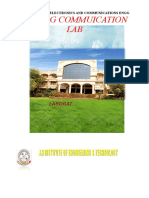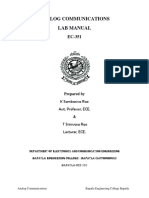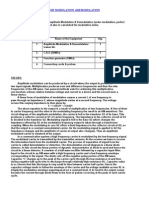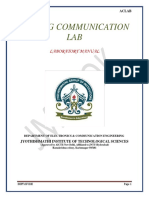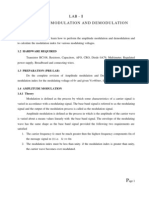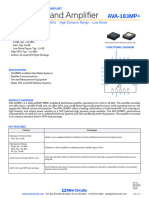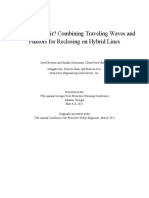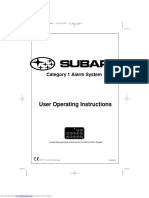AC Lab Final
Uploaded by
kramsai349AC Lab Final
Uploaded by
kramsai349UCE, AKNU Analog Communication Lab
ANALOG COMMUNICATION
LABORATORY MANUAL
II – B. Tech., II-Semester ECE
DEPARTMENT OF ELECTRONICS AND COMMUNICATION ENGINEERING
UNIVERSITY COLLEGE OF ENGINEERING
ADIKAVI NANNAYA UNIVERSITY
Department of Electronics and Communication Engineering 1
UCE, AKNU Analog Communication Lab
LIST OF EXPERIMENTS
1. Amplitude Modulation - Modulation &Demodulation.
2. AM - DSB SC - Modulation &Demodulation.
3. AM - SSB SC - Modulation &Demodulation.
4. Balance Modulator.
5. Diode Detector.
6. Pre-emphasis &De-emphasis.
7. Frequency Modulation - Modulation &Demodulation.
8. Digital Phase Detector.
9. Synchronous Detector.
10. AGC Circuits.
11. Characteristics of Mixer.
12. Verification of Sampling Theorem.
13. Pulse Amplitude Modulation &Demodulation.
14. PWM, PPM –Modulation &Demodulation.
15. PLL IC-565 as FM Demodulator.
16. Radio receiver characteristics.
Department of Electronics and Communication Engineering 2
UCE, AKNU Analog Communication Lab
Expt. No: 1 AMPLITUDE MODULATION &DEMODULATION
AIM: To study the function of Amplitude Modulation & Demodulation (under modulation, perfect
modulation & over modulation) and also to calculated the modulation index.
APPARATUS:
1. Amplitude Modulation & Demodulation trainer kit.
2. C.R.O (20MHz)
3. Function generator (1MHz).
4. Connecting cords & probes.
INTRODUCTION
This Educational trainer is a useful educational kit for the demonstration of:
1. Amplitude modulation
2. Demodulation
This kit consists of wired circuitry of:
1. RF Generator
2. AF Generator
3. Regulated power supply
4. Modulator
5. Demodulator
Block Diagram Description:
1. RF Generator:
Colpitts oscillator using FET is used here to generate RF signal of approximately 1MHz Frequency to
use as carrier signal in this Experiment. Adjustments for amplitude and frequency are provided on panel
for ease of operation.
2. AF Generator:
Low frequency signal of approximately 2 KHz is generated using OP-AMP based wein bridge oscillator,
required amplification and adjustable attenuation are provided.
Department of Electronics and Communication Engineering 3
UCE, AKNU Analog Communication Lab
3. Regulated power supply:
This consists of bridge rectifier, capacitor filters and three terminal regulators to provide required dc
voltages in the circuit i.e +12v, _12v &150 mA each.
4. Modulator:
modulator section illustrates the circuit of modulating amplifier employing a transistor (BC 107) as an
active device in common emitter amplifier mode. R1 and R2 establishes a quiescent forward bias for the
transistor. The modulating signal is fed at the emitter section causes the bias to increase or decrease in
accordance with the modulating signal.
R4 is emitter resistance and C3 is by pass capacitor for carrier.
Thus the carrier signal applied at the base gets amplified more when the amplitude of the modulating
signal is at its maximum and less when the signal by the modulating signal output is a amplitude
modulated signal.C2 couples the modulated signal to output of the Modulator.
5. Demodulator:
Demodulation involves two operations:
1. Rectification of the modulated wave and
2. Elimination of RF components of the rectified modulated wave.
Signal is applied to anode and output is taken from cathode, diode operates as half wave rectifier and
passes only positive half cycle of the modulated wave. Further signal is applied to sharp low pass filter
formed by Rd and CD low pass filter allows only low frequency signal to output and it bye passes RF
component to the ground
Experimental procedure:
1. As the circuit is already wired you just have to trace the circuit according to the circuit diagram
given above.
2. connect the trainer to the mains and switch on the power supply.
3. Measure the output voltages of the regulated power supply circuit i.e +12v and _12v.
4. Observe outputs of RF and AF signal generator using CRO, note that RF voltage is approximately
300mv pp of 1 MHz frequency and AF voltage is 10vpp of 2KHz frequency.
Modulator
5. Now connect RF and AF signals to the respective inputs of modulator.
6. Initially set both the signals at zero level.
7. Connect one of the input of oscilloscope to modulator output and other input to AF signal.
Department of Electronics and Communication Engineering 4
UCE, AKNU Analog Communication Lab
8. Adjust RF signal amplitude with the help of potentiometer so the t output of the modulator is 300mv pp
by keeping AF signal at zero level.
9. Now vary the amplitude of AF signal and observe the amplitude modulated wave at output, note the
percentage of modulation for different values of AF signal.
%modulation= (B – A / B + A) X 100
10. Observe 100% amplitude modulation and over modulation by varying amplitude of the AF signal.
Demodulator
11. Now connect the modulator output to the demodulator input.
12. Observe demodulated signal at output of demodulator at approximately 50% modulation using
oscilloscope.
13. Compare it with the original AF signal (Note: only wave shape, amplitude will be attenuated, phase
may change.)
14. Find the detected signal is same as the AF signal applied. Thus no information is lost in the process of
modulation.
15. If you want to observe AM wave at different frequencies then connect AF signal from external signal
generator to the modulator and observe amplitude modulated wave are different frequencies.
EXPECTED WAVEFORMS: -
Department of Electronics and Communication Engineering 5
UCE, AKNU Analog Communication Lab
Department of Electronics and Communication Engineering 6
UCE, AKNU Analog Communication Lab
RESULT
QUESTIONS
1.Define AM and draw its spectrum?
2.Draw the phases representation of an amplitude modulated wave?
3.Give the significance of modulation index?
4.What are the different degree of modulation?
5.What are the limitations of square law modulator?
6.Compare linear and nonlinear modulators?
7.Compare base modulation and emitter modulation?
8.Explain how AM wave is detected?
9.Define detection process?
10.What are the different types of distortions that occur in an envelop detector? How can they be
eliminated?
Department of Electronics and Communication Engineering 7
UCE, AKNU Analog Communication Lab
Expt. No: 2 AM - DSB SC - MODULATION &DEMODULATION
AIM: To study the working of the Balanced Modulator and demodulator.
APPARATUS:
1. Balanced modulator trainer kit
2. C.R.O (20MHz)
3. Connecting cords and probes
4. Function generator (1MHz)
THEORY:
Balanced modulator circuit is used to generate only the two side bands DSB-SC. The balanced
modulation system is a system is a system of adding message to carrier wave frequency there by only the
side bands are produced. It consists of two AM modulators arranged in a balanced configuration. The
AM modulator is assumed to be identical. The carrier input to the two modulators is same.
If we eliminate or suppress the carrier, then the system becomes suppressed carrier DSB-SC. In
this we need reinsert the carrier is complicated and costly. Hence the suppressed carrier DSB system may
be used in point to point communication system.
Generation of suppressed carrier amplitude modulated volt balanced modulator maybe of the
following types.
1. Using transistors or FET.
2. Using Diodes
Department of Electronics and Communication Engineering 8
UCE, AKNU Analog Communication Lab
EXPECTED WAVE FORMS: -
Department of Electronics and Communication Engineering 9
UCE, AKNU Analog Communication Lab
RESULT:
QUESTIONS:
1. What are the two ways of generating DSB_SC?
2. What are the applications of balanced modulator?
3. What are the advantages of suppressing the carrier?
4. What are the advantages of balanced modulator?
5. What are the advantages of Ring modulator?
6. Write the expression for the output voltage of a balanced modulator?
7. Explain the working of balanced modulator and Ring Modulator using diodes.
Department of Electronics and Communication Engineering 10
UCE, AKNU Analog Communication Lab
Expt. No: 3 AM - SSB SC - MODULATION &DEMODULATION
AIM: To generate SSB using phase method and demodulation of SSB signal using
Synchronous detector.
APPARATUS: 1. SSB trainer kit
2. C.R.O (20MHz)
3. Function Generator (1MHz).
CIRCUIT DIAGRAM:
THEORY:
Single side band signal generation using Phase shift method and demodulation of SSB signal using
Synchronous detector. This exp consists of
1.R.F generator.
2.A.F generator.
3.Two balanced modulators.
4.Synchronous detector
5.Summer
6.Subtractor
Department of Electronics and Communication Engineering 11
UCE, AKNU Analog Communication Lab
1.RF generator:
Colpitts oscillator using FET is used here to generate RF signal of approximately 100KHz frequency
to use as carrier signal in this experiment. Phase shift network is included in the same block to produce
another carrier signal of same frequency with 900 out of phase. An individual control is provided to vary the
output voltage. Facility is provided to adjust phase of the output signal.
2.AF generator:
This is a sine cosine generator using OP-OMP. IC TL 084 is used as an active component; TL 084
is a FET input general purpose quad op-amp integrated circuit. A three position switch is provided to select
output frequency. An individual control is provided to vary the output voltage.AGC control is provided to
adjust the signal shape.
3.Balanced Modulator:
This has been developed using MC 1496 IC, is a monolithic integrated circuit Balanced
modulator/demodulator, is versatile and can be used up to 200MHz. These modulators are used in this
experiment to produce DSB_SC signals. Control is provided to balance the output.
5. Summer and Subtractors:
These circuits are simple summing and subtracting amplifiers using OP-AMP. IC TL084 is used as
an active component, TL 084 is a FET input general purpose quad OP-AMP integrated circuit.
The phase shift method makes use of two balanced modulators and two phase shift networks as
shown in figure. One of the modulators receives the carrier signal shifted by 90 0 and the modulating signal
with 00 (sine) phase shift, where as the other receives modulating signal shifted by 900 (cosine ) and the
carrier ( RF) signal with 00 phase shift voltage.
Both modulators produce an output consisting only of sidebands. It will be shown that both upper
sidebands lead the reference voltage by 900, and the other lags it by 900. The two lower side bands are thus
out of phase and when combined in the adder, they cancel each other. The upper side bands are in phase at
the adder and therefore they add together and gives SSB upper side band signal. When they combined in
the subtractor, the upper side bands are canceling because in phase and lower side bands add together and
gives SSB lower side band signal.
Department of Electronics and Communication Engineering 12
UCE, AKNU Analog Communication Lab
PROCEDURE:
SSB MODULATION
1.Connect the circuit as per the given circuit diagram.
2.Switch on the kit and measure the output of regulated power supplies positive and
negative voltages.
3.Observe the outputs of RF generators using CRO. Where one output is 0 0phase the
another is 900 phase shifted(or) is a sine wave and shifted w.r.t other (or) is a cosine
wave.
4. Adjust the RF output frequency as 100KHz and amplitude as 0.2 Vp-p
(Potentiometers are provided to vary the output amplitude & frequency).
5. Observe the two outputs of AF generator using CRO.
6. Select the required frequency (2kHz, 4kHz, 6kHz) form the switch positions for
A.F.
7. Adjust the gain of the oscillator by varying the AGC potentiometer and keep the
amplitude of 10Vp-p.
8. Measure and record the above seen signals & their frequencies on CRO.
9. Set the amplitude of R.F signal to 0. 2Vp-p and A.F signal amplitude to 8Vp-p and
connect AF-00 and RF-900 to inputs of balanced modulator A and observe DSB-
SC(A) output on CRO. Connect AF-900 and RF-00 to inputs of balanced modulator
B and observe the DSB-SC (B)out put on CRO and plot the same on graph.
10. To get SSB lower side band signal connect balanced modulator outputs (DSB-SC)
to subtractor and observe the output wave form on CRO and plot the same on
graph.
11. To get SSB upper side band signal, connect the output of balanced modulator
outputs to summer circuit and observe the output waveform on CRO and plot the
same on graph.
12.Calculate theoretical frequency of SSB (LSB & USB) and compare it with
Department of Electronics and Communication Engineering 13
UCE, AKNU Analog Communication Lab
practical value.
USB = RF frequency + AF frequency.
LSB = RF frequency – AF frequency.
EXPECTED WAVE FORMS: -
Department of Electronics and Communication Engineering 14
UCE, AKNU Analog Communication Lab
RESULT:
QUESTIONS:
1.What are the two ways of generation of SSB wave?
2.What are the features of filter method generation of SSB?
3.What are the advantages of phase shift method of SSB generation?
4.What are the disadvantages of phase shift method of SSB generation?
5.What are the advantages of SSB-SC AM?
6. What are the disadvantages of SSB-SC AM?
7. What are the applications of SSB-SC AM?
Department of Electronics and Communication Engineering 15
UCE, AKNU Analog Communication Lab
Expt. No: 4 BALANCED MODULATOR
AIM: To study the following of the Balanced Modulator as a
1. Frequency Doubler
2. DSB-SC Generator.
APPARATUS:
1. Balanced modulator trainer kit
2. C.R.O (20MHz)
3. Connecting cords and probes
4. Function generator (1MHz)
CIRCUIT DIAGRAM:
Department of Electronics and Communication Engineering 16
UCE, AKNU Analog Communication Lab
THEORY:
1. RF Generator:
Colpitts oscillator using FET is used here to generate RF signal of approximately 100 KHz
Frequency to use as carrier signal in this experiment. Adjustments for Amplitude and Frequency are
provided in panel for ease of operation.
2. AF Generator:
Low Frequency signal of approximately 5KHz is generated using OP-AMP based wein bridge
oscillator. IC TL 084 is used as an active component; TL 084 is FET input general purpose quad OP-AMP
integrated circuit. One of the OP-AMP has been used as amplifier to improve signal level. Facility is
provided to change output voltage.
3. Regulated Power Supply:
This consists of bridge rectifier, capacitor filters and three terminal regulators to provide required dc
voltage in the circuit i.e. +12v, -8v @ 150 ma each.
4. Modulator:
The IC MC 1496 is used as Modulator in this experiment. MC 1496 is a monolithic integrated circuit
balanced modulator/Demodulator, is versatile and can be used up to 200 Mhz.
Multiplier:
A balanced modulator is essentially a multiplier. The output of the MC 1496 balanced modulator is
proportional to the product of the two input signals. If you apply the same sinusoidal signal to both inputs
of a ballooned modulator, the output will be the square of the input signal AM-DSB/SC: If you use two
sinusoidal signals with deferent frequencies at the two inputs of a balanced modulator (multiplier) you can
produce AM-DSB/SC modulation. This is generally accomplished using a high- frequency “carrier”
sinusoid and a lower frequency “modulation” waveform (such as an audio signal from microphone). The
figure 1.1 is a plot of a DSB-SC waveform, this figure is the graph of a 100KHz and a 5 KHz sinusoid
multiplied together. Figure 1.2 shows the circuit that you will use for this experiment using MC 1496
balanced modulator/demodulator.
Department of Electronics and Communication Engineering 17
UCE, AKNU Analog Communication Lab
PROCEDURE:
I-Frequency Doubler
1. Connect the circuit as per the given circuit diagram.
2. Switch on the power to the trainer kit.
3. Apply a 5 KHz signal to both RF and AF inputs of 0.1VP-P.
4. Measure the output signal frequency and amplitude by connecting the output to CRO.
5. Repeat the steps 3 and 4 by changing the applied input signal frequency to 100KHZ and
500KHz. And note down the output signals.
NOTE: - Amplitude decreases with increase in the applied input frequency
II-Generation of DSB-SC
1. For the same circuit apply the modulating signal(AF) frequency in between 1Khz to 5Khz
having 0.4 VP-P and a carrier signal(RF) of 100KHz having
a 0.1 VP-P .
2. Adjust the RF carrier null potentiometer to observe a DSB-SC waveform at
the output terminal on CRO and plot the same.
3. Repeat the above process by varying the amplitude and frequency of AF but RF maintained
constant.
NOTE :- Note down all the waveforms for the applied inputs and their respective outputs.
EXPECTED WAVE FORMS: -
Department of Electronics and Communication Engineering 18
UCE, AKNU Analog Communication Lab
Note: In frequency doubling If the input time period is “T” after frequency doubling the time period should
be halfed.i.e,”T/2”.
RESULT:
QUESTIONS
1.What are the two ways of generating DSB_SC.
2.What are the applications of balanced modulator?
3.What is the advantages of suppressing the carrier?
4.What are the advantages of balanced modulator?
5.What are the advantages of Ring modulator?
6.Write the expression for the output voltage of a balanced modulator?
Department of Electronics and Communication Engineering 19
UCE, AKNU Analog Communication Lab
Expt. No:5 PRE-EMPHASIS & DE-EMPHASIS
AIM: To study the functioning of Pre-Emphasis and De-Emphasis circuits.
APPARATUS:
1.Pre-emphasis & De-emphasis trainer kits.
2. C.R.O (20MHz )
3. Function generator (1MHz).
4. Patch chords and Probes.
CIRCUIT DIAGRAM:
Department of Electronics and Communication Engineering 20
UCE, AKNU Analog Communication Lab
THEORY:
Frequency modulation is much immune to noise than amplitude modulation and significantly more
immune than phase modulation. A single noise frequency will affect the output of the receiver only if it falls
within its pass band.
The noise has a greater effect on the higher modulating frequencies than on lower ones. Thus, if
the higher frequencies were artificially boosted at the transmitter and correspondingly cut at the receiver,
improvement in noise immunity could be expected. This booting of the higher frequencies, in accordance
with a pre-arranged curve, is termed pre-emphasis, and the compensation at the receiver is called de-
emphasis.
If the two modulating signals have the same initial amplitude, and one of them is pre-emphasized
to (say) twice this amplitude, whereas the other is unaffected (being at a much lower frequency) then the
receiver will naturally have to de-emphasize the first signal by a factor of 2, to ensure that both signals
have the same amplitude in the output of the receiver. Before demodulation, I.e. while susceptible to noise
interference the emphasized signal had twice the deviation it would have had without pre-emphasis, and
was thus more immune to noise. Alternatively, it is seen that when this signal is de-emphasized any noise
sideband voltages are de-emphasized with it, and therefore have a correspondingly lower amplitude than
they would have had without emphasis again their effect on the output is reduced.
The amount of pre-emphasis in U.S FM broadcasting, and in the sound transmissions accompanying
television, has been standardized at 75 microseconds, whereas a number of other services, notably CCIR
and Australian TV sound transmission, use 50 micro second. The usage of microseconds for defining
emphasis is standard. 75 microseconds de-emphasis correspond to a frequency response curve that is 3 db
down at the frequency whose time constant is RC is 75 microseconds. This frequency is given by f=1/2RC
and it is therefore 2120 Hz; with 50-microseconds de-emphasis it would have been 3180 Hz. Figure I shows
pre emphasis and de-emphasis curves for a 7 microseconds emphasis, as used in the united states.
If emphasis is applied to amplitude modulation, some improvement will also result, but it is not as
great as in FM because the highest modulating frequencies in AM are no more affected by noise than any
others.
Apart from that, it would be difficult to introduce pre-emphasis and de-emphasis in existing AM services
since extensive modifications would be needed, particularly in view of the huge numbers is receivers in use.
Department of Electronics and Communication Engineering 21
UCE, AKNU Analog Communication Lab
PROCEDURE:
I-PRE-EMPHASIS
1. Connect the circuit as per the circuit diagram
2. Apply a sine wave to the input terminals of 2 VP-P (Vi)
3. By varying the input frequency with fixed amplitude, note down the output amplitude (Vo) with
respect to the input frequency.
4. Calculate the gain using the formula
Gain = 20 log (VO/ VI) db
Where VO = output voltage in volts.
VI = Input voltage in volts.
And plot the frequency response.
II-DE-EMPHASIS
1. Connect the circuit as per circuit diagram.
2. Repeat steps 2,3 & 4 of Pre-Emphasis to de-emphasis also.
EXPECTED WAVEFORMS
Gain Gain
(-db) (-db)
Frequency(Hz-khz) Frequency(Hz-khz)
Fig: Pre-emphasis Fig: De-emphasis
Department of Electronics and Communication Engineering 22
UCE, AKNU Analog Communication Lab
TABULAR COLUMN:-
VI =2v
S.No Input Frequency Out put voltage (Vo) GAIN
(volts)
(50Hz to 20KHz) 20 log (VO/ VI) db
RESULT:
QUESTIONS
1.What is the need for pre-emphasis?
2.Explain the operation of pre-emphasis circuit?
3.Preemphasis operation is similar to high pass filter explain how?
4.Deemphasis operation is similar to low pass filter justify?
5.What is de-emphasis?
6.Draw the frequency response of a pre-emphasis circuit?
7. Draw the frequency response of a de-emphasis circuit?
Department of Electronics and Communication Engineering 23
UCE, AKNU Analog Communication Lab
Expt. No 6: FREQUENCY MODULATION & DEMODULATION
AIM: To study the functioning of frequency modulation & demodulation and to calculate the modulation
index.
APPARATUS:
1.Frequency modulation & demodulation trainer kit.
2. C.R.O (20MHz)
3.Function generator (1MHz).
4. Connecting chords & probes.
CIRCUIT DIAGRAM:
FREQUENCY MODULATION CIRCUIT DIAGRAM:
Department of Electronics and Communication Engineering 24
UCE, AKNU Analog Communication Lab
FREQUENCY DEMODULATION CIRCUIT DIAGRAM:
THEORY:
This kit consists of wired circuitry of:
1. AF generator.
2. Regulated power supply
3. Modulator.
4. Demodulator.
1. AF Generator:
This is an op-amp placed wein bridge oscillator. A FET input quad Op-Amp (ICTL084) is used here
to generate low frequency signals of 500 Hz and 5KHz to use as modulating signal. In this
Department of Electronics and Communication Engineering 25
UCE, AKNU Analog Communication Lab
experiment, a switch is provided to change the frequency. Required amplification is provided to
avoid loading effect.
2. Regulated power supply:
This consists of bridge rectifier, capacitor filters and three terminal regulators to provide required
dc voltages in the circuit i.e. +15 V, -15 V, +5V .
3. Modulator:
This has been developed using XR-2206 integrated circuit. The IC XR-2206 is a monolithic Function
generator; the output waveforms can be both amplitude and frequency modulated by an external
voltage. Frequency of operation can be selected externally over a range of 0.01 MHz. The circuit is
ideally suited for communications, instrumentations and function generator applications requiring
sinusoidal tone, AM, FM or FSK generation. In this experiment, IC XC-2206 is connected to
generate sine wave, which is used as a carrier signal. The amplitude of carrier signal is 5vPP of 100
KHz frequencies.
4. Demodulator:
This had been developed using LM4565 integrated circuit. The IC LM565 is a general-
purpose phase locked loop containing a stable, highly linear voltage controlled oscillator for low
distortion FM demodulation.
The VCO free running frequency f0 is adjusted to the center frequency of input frequency
modulated signal i.e. carrier frequency which is of 100 KHz. When FM signal is connected to the
demodulator input, the deviation in the input signal (FM signal) frequency which creates a DC error
voltage at output of the phase comparator which is proportional to the change of frequency f. This
error voltage pulls the VCO to the new point. This error voltage will be the demodulated version of
the frequency modulated input signal.
PROCEDURE:
1. Switch on the power supply of the kit (without making any connections).
2. Measure the frequency of the carrier signal at the FM output terminal with input terminals open and
plot the same on graph.
3. Connect the circuit as per the given circuit diagram.
4. Apply the modulating signal of 500HZ with 1Vp-p.
Department of Electronics and Communication Engineering 26
UCE, AKNU Analog Communication Lab
5. Trace the modulated wave on the C.R.O & plot the same on graph.
6. Find the modulation index by measuring minimum and maximum frequency deviations from the carrier
frequency using the CRO.
S maximum Frequency deviation
Mr
f modulating signal frequency
7. Repeat the steps 5& 6 by changing the amplitude and /or frequency of the modulating Signal.
8. For demodulation apply the modulated signal as an input to demodulator circuit and compare the
demodulated signal with the input modulating signal & also draw the same on the graph.
EXPECTED WAVEFORMS
Department of Electronics and Communication Engineering 27
UCE, AKNU Analog Communication Lab
NOTE: Note down all the input and output wave forms of the signals applied and obtained respectively.
RESULT:
QUESTIONS
1.Define frequency modulation?
2.Mention the advantages of indirect method of FM generation?
3.Define modulation index and frequency deviation of FM?
4.What are the advantages of FM?
5.What is narrow band FM?
6.Compare narrow band FM and wide band FM?
7.Differentiate FM and AM
Department of Electronics and Communication Engineering 28
UCE, AKNU Analog Communication Lab
Expt. No:7 SYNCHRONOUS DETECTOR
AIM: To generate SSB using phase method and detection of SSB signal using Synchronous detector.
APPARATUS:
1. SSB trainer kit
2. C.R.O (20MHz)
3. Patch cards
4. CRO probes
Department of Electronics and Communication Engineering 29
UCE, AKNU Analog Communication Lab
THEORY:
AM and DSBSC modulation are wasteful of band width because they both require a transmission
bandwidth which is equal to twice the message bandwidth in SSB only one side band and the carrier is
used. The other side band is suppressed at the transmitter, but no information is lost. Thus the
communication channel needs to provide the same band width, when only one side band is transmitted.
So the modulation system is referred toas SSB system.
The base band signal may not be recovered from a SSB signal by the Use of a diode modulator.
The bae band signal can be recovered if the spectral component of the output i.e either the LSB or USB
is multiplied by the carrier signal.
Consider the modulating signal
M(t)=Am cos Wmt C(t)=Ac
cosWct
M(t)c(t)= AcAm cosWmt cosWct
The above signal when passed through a filter, only one of the above component is obtained which
lays the SSB signal.
PROCEDURE:-
SSB MODULATION
1. Connect the Adaptor to the mains and the other side to the Experimental Trainer Switch ‘ON’
the power.
2. (a) Connect carrier fc 900 to Ain of Balanced Modulator –A and adjust its amplitude to0.1Vpp.
(b). Connect modulating signal fm 00 5Vpp to Bin of the Balanced Modulator-A.
3. Observe the DSB-A output on CRO.
4. Connect fc 00 at 0.1 Vpp at Cin of Balanced Modulator B. Connect fm 900 at 5 Vpp at Din of Balanced
Modulator B.
5. Connect the DSB-A output and DSB-B output to the summing amplifier. Observe the output (SSB
output) on the spectrum analyzer. This gives single side band (upper) only while the lower side band is
cancelled in the summing Amplifier.
Department of Electronics and Communication Engineering 30
UCE, AKNU Analog Communication Lab
SSB DEMODULATION
1. Connect the carrier fc 00 and SSB output to the synchronous detector.
2. Connect the demodulator output on the oscilloscope which is the recovered modulating signal.
Department of Electronics and Communication Engineering 31
UCE, AKNU Analog Communication Lab
Department of Electronics and Communication Engineering 32
UCE, AKNU Analog Communication Lab
Expt. No:8 PHASE LOCKED LOOP
AIM: To study the characteristics of PLL.
APPARATUS:
1. PLL Trainer Kit
2. C R O (20MHz)
3. Digital Multimeter
PLL BLOCK DIAGRAM:
Department of Electronics and Communication Engineering 33
UCE, AKNU Analog Communication Lab
PLL CIRCUIT DIAGRAM:
THEORY:
Phase Locked Loop is a versatile electronic servo system that compares the phase and frequency of
a given signal with an internally generated reference signal. It is used in various applications like frequency
multiplication, FM detector, AM modulator & De modulator and FSK etc.,
Free running frequency (f0):
When there is no input signal applied to pin no:2 of PLL,it is in free running mode and the free
running frequency is determined by the circuit elements Rt and Ct and is given by
F0 = 0.3/(RtCt) where Rt is the timing resistor
Ct is the timing capacitor
Lock range of PLL (fL):
Lock range of PLL is in the range of frequencies in which PLL will remain lock, and this is given
by
fL = 8f0 /VCC Where f0 is the free running frequency
VCC = VCC –(- VCC)
= 2 VCC
Department of Electronics and Communication Engineering 34
UCE, AKNU Analog Communication Lab
Capture range(fC):
The capture range of PLL is the range of frequencies over which PLL acquires the lock. This is
given by
1 2f L
fC = Where fL is the lock range and
2 3.6 x10 3 xCC
CC is filter capacitor
R = 3.6 X 103
PROCEDURE:
Free running frequency:
1. Switch on the trainer and measure the output of the regulated power supplies i.e., +12V and 5V
2. Observe the output of the square wave generator-using oscilloscope and measure the frequency
range. The frequency range should be around 1KHz to 10KHz.
3. Calculate the free running frequency range of the circuit for different values of timing capacitor and
Rt.
4. Connect 0.1F capacitor (CC) to the circuit and open the loop by removing short between pin 4 and
5 . Measure the minimum and maximum free running frequencies obtainable at the output of the
PLL (Pin 4)by varying the pot. Compare your results with your calculation from step 3 (theoretical
value). Simultaneously you can observe the output signal using CRO.
Table 1: 1 Free running frequency
Rt value (pot resistance Theoretical value Practical value
in Ohms)
(frequency in KHz) (frequency KHz)
Department of Electronics and Communication Engineering 35
UCE, AKNU Analog Communication Lab
Lock range:
5. Calculate the lock range of the circuit for a 5KHz free running frequency and record in table 1.2.
6. Connect pins 4,5 with the help of springs and adjust potentiometer to get a free running frequency
of 5KHz . Connect square wave generator output to the input of PLL circuit. Provide a 5KHz square
signal of 1 Vpp approximately (make this input frequency as close to the Vcc frequency as possible).
7. Observe the input & Output of the PLL.
8. Observe the input and output frequencies while slowly increasing the frequency of the square wave
at the input. For some range output and input are equal (This is known as lock Range and PLL is
said to be in lock with the input signal). Record the frequency at which the PLL breaks lock. (Output
frequency of the PLL will be around VCO frequency and in oscilloscope you will see a jittery
waveform when it breaks lock instead of clean square wave). This frequency is called as upper end
of the lock range and records this as F2.
9. Beginning at 5KHz, slowly decrease the frequency of the input and determine the frequency at which
the PLL breaks lock on the low end record it as F1
10. Find the lock range from F2 – F1 and compare with the theoretical values from step5.
Lock range Table 1.2:
Theoretical Value Practical Value
(frequency in KHz) (frequency in KHz)
Capture range:
11. Calculate the capture range of the circuit for a 5KHz free-running frequency (consider filter capacitor
(CC) is 0.1F).
12. With the oscilloscope and counter still on pin 4, slowly increase the input frequency from minimum
(say 1KHz), Record frequency (as F3) at which the input and output frequencies of the PLL are
equal, this is known as lower end of the capture range.
13. Now keep input frequency at maximum possible (say 10KHz) and slowly reduce and record the
frequency (as F4) at which the input and output frequencies of PLL are equal. This is known as
upper end of the capture range.
14. Find capture range from F4 – F3 and compare it with the theoretical value (from step 11)
15. Repeat the steps from 11 to 14 with CC value 0.2F
Department of Electronics and Communication Engineering 36
UCE, AKNU Analog Communication Lab
Capture range:
Filter Capacitor (CC) Theoretical value Practical value
0.1F
0.2F
Characteristics of PLL :
F1 F3 fo F4 F2
Capture range
Lock range
RESULT:
QUESTIONS
1.What are the applications of PLL?
2.What is a PLL?
3.What is a VCO?
4.Define the lock range of a PLL?
5.Define the capture range of PLL?
6.Give the expression for free running frequency f0 of a PLL?
7.What is meant by the free running frequency of a PLL?
8. Give the formulae for the lock range and capture range of the PLL?
Department of Electronics and Communication Engineering 37
UCE, AKNU Analog Communication Lab
Department of Electronics and Communication Engineering 38
You might also like
- Analog Communications Lab Manual - AsraoNo ratings yetAnalog Communications Lab Manual - Asrao128 pages
- Analog and Digital Communication LAB Manual100% (1)Analog and Digital Communication LAB Manual72 pages
- III/IV B.Tech (ECE) Sixth Semester: Ec361 - Digital Communication LabNo ratings yetIII/IV B.Tech (ECE) Sixth Semester: Ec361 - Digital Communication Lab66 pages
- Analog and Digital Communincations Laboratory Manual: Department of ICT Engineering Gec, BhavnagarNo ratings yetAnalog and Digital Communincations Laboratory Manual: Department of ICT Engineering Gec, Bhavnagar95 pages
- Analog Communications Lab Manual Ec 351No ratings yetAnalog Communications Lab Manual Ec 35146 pages
- Pulse Amplitude Modulation and Demodulation - Google SearchNo ratings yetPulse Amplitude Modulation and Demodulation - Google Search30 pages
- Analog & Digital Communications Lab Manual100% (1)Analog & Digital Communications Lab Manual57 pages
- MIC College of Technology: Instruction ManualNo ratings yetMIC College of Technology: Instruction Manual101 pages
- Communication-I Lab Manual EEC-552: Department of Electronics and Communication EngineeringNo ratings yetCommunication-I Lab Manual EEC-552: Department of Electronics and Communication Engineering27 pages
- Communication Lab Manual 2022 Scheme - BECL404 - 23-04-2024No ratings yetCommunication Lab Manual 2022 Scheme - BECL404 - 23-04-202456 pages
- Lab - 1 Amplitude Modulation and Demodulation: 1.1 ObjectiveNo ratings yetLab - 1 Amplitude Modulation and Demodulation: 1.1 Objective13 pages
- Communications Lab Manual Amplitude Modulation and DSB-SC75% (4)Communications Lab Manual Amplitude Modulation and DSB-SC85 pages
- SW-HF 5.1 4500 SERVICE GUIDE - PDF - GeniusNo ratings yetSW-HF 5.1 4500 SERVICE GUIDE - PDF - Genius33 pages
- Datasheet Axis A4011 e Reader en US 296074No ratings yetDatasheet Axis A4011 e Reader en US 2960742 pages
- C&D 2-200LBT: Valve Regulated Lead Acid BatteryNo ratings yetC&D 2-200LBT: Valve Regulated Lead Acid Battery2 pages
- Troubleshooting The NAE/NIE .............................................................. 2No ratings yetTroubleshooting The NAE/NIE .............................................................. 211 pages
- Subaru Category 1 Alarm System User Operating InstructionsNo ratings yetSubaru Category 1 Alarm System User Operating Instructions19 pages
- Spare Parts and Repair: Simovert MasterdrivesNo ratings yetSpare Parts and Repair: Simovert Masterdrives4 pages
















